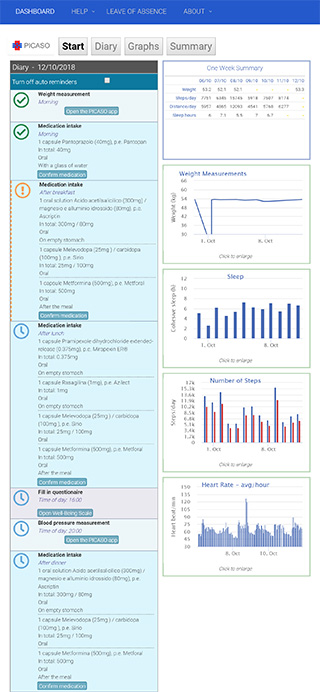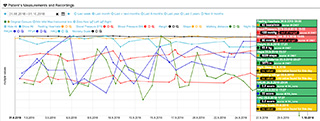Presentation of the PICASO platform for integrated patient care a resounding success
The European PICASO project, coordinated by Fraunhofer FIT, is developing a web platform for the integrated care of patients with multiple chronic conditions (multimorbidities). The project focuses on improving information sharing among the different medical specialists involved and on supporting patients in managing their conditions. Our presentation of the project's interim results at the 46th Congress of Deutsche Gesellschaft für Rheumatologie (DGRh) was very well received by the experts attending the conference.


For years, the number of people with multiple chronic conditions is increasing and will continue to do so in an ageing society. According to the Deutscher Alterssurvey (DEAS), currently two thirds of all patients in the 55 – 69 age range suffer from multiple chronic conditions. For older patients the likelihood rises to over 80 percent. These patients require medical treatment by several specialists and individually tailored therapy. One of the challenges here is that information is not shared among all those involved in a patient's treatment. This may lead to drugs being prescribed without taking into account drug-drug interactions.
To improve this situation, the European PICASO project (Personalized Integrated Care Approach for Service Organizations) is developing tools and care models for patients with multimorbidities. At its core is a web platform that will significantly improve communication among all the actors involved in treatment and care, allowing cardiologists, rheumatologists, radiologists, general practitioners, physiotherapists, nurses and patients’ relatives to share information more effectively. Doctors can use the PICASO platform to set-up for their patients individual care plans that comply with the current HL7 FHIR® (Fast Healthcare Interoperability Resource) standard. This standard enables interoperability and thus lets clinics and GPs share information though they typically use different kinds of documentation systems.
Beyond this, PICASO aims to foster patient empowerment by providing patients information about their personal health status to better understand how this interacts with their own behavior Our PICASO patient dashboard was developed to achieve this. It shows the patient’s individual care plan and the activities planned for a particular day, e.g. when and how a specific medication or a blood pressure measurement should be taken. The patient can use the patient dashboard to confirm drug intake as prescribed or to record a deviation from the prescription. If the patient opts in, the dashboard will provide reminders for planned activities. Patients can view the results of the measurements they take either in individual charts or together in an overview chart.
The physicians and caregivers use the clinician dashboard. It shows a complete overview of the treatment history. Here physicians can rapidly find out which other physicians or medical professionals have been involved in the patient’s treatment and which diagnostic information is already available. And they can use it to set up care plans, e.g. covering medication, the frequency of blood pressure measurements and if additional specialists or medical professionals should be involved in the treatment. Results from home measurements and self-recordings can be viewed here as well.
A communication module makes it easier for the physicians to share information. Another tool helps to forecast the patient’s health risk based on historic and current health-related information, e.g. on the patient's pattern of physical exercise, smoking habits or cholesterol level data.
»Both dashboards are currently undergoing user tests. One field trial is carried out in Rome, Italy, by Tor Vergata University and the Department of Psychiatry of the Institute of Treatment and Research, Santa Lucia of Rome. It involves patients with Parkinson’s disease, and also their caring relatives. They can use a tablet to access the patient dashboard, e.g. to check if the patient has confirmed all necessary tasks of the day. We want to find out if this kind of application can actually assist caring relatives in coping with their caring tasks«, says Henrike Gappa, who is involved in the PICASO project at Fraunhofer Institute for Applied Information Technology FIT.
The second field test, organized by the Policlinic of Rheumatology & Hiller Research Unit at Heinrich Heine University in Düsseldorf, started only recently. It involves 30 of their outpatients who suffer from rheumatoid arthritis plus a cardiovascular condition. These patients and their physicians will evaluate the PICASO platform over a period of 6 months.
To very positive feedback from the medical professionals, the PICASO project demonstrated both the patient dashboard and the clinician dashboard at the joint 46th Congress of Deutsche Gesellschaft für Rheumatologie (DGRh), 32nd Annual Conference of Deutsche Gesellschaft für Orthopädische Rheumatologie (DGORh) and Scientific Autumn Conference of Gesellschaft für Kinder- und Jugendrheumatologie (GKJR).
For additional information please visit www.picaso-project.eu.